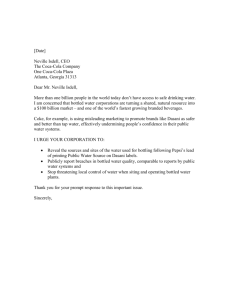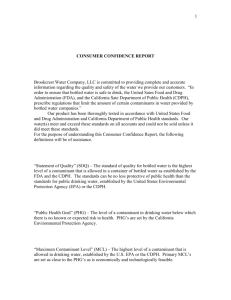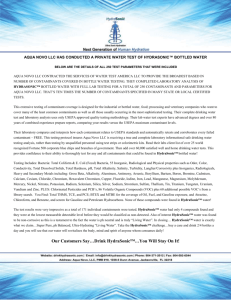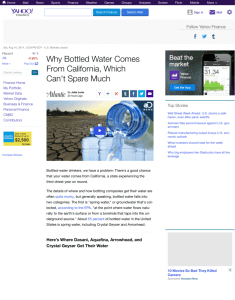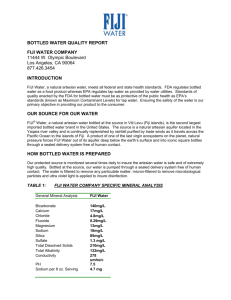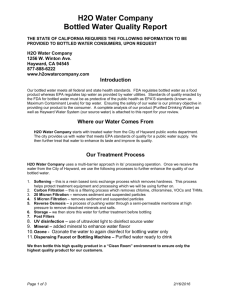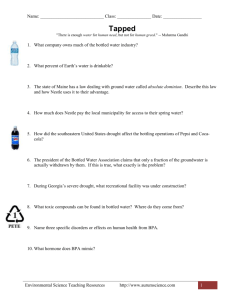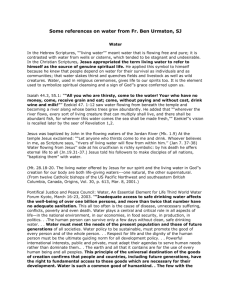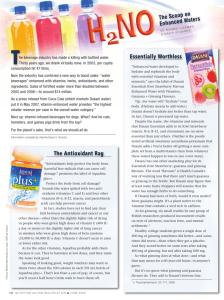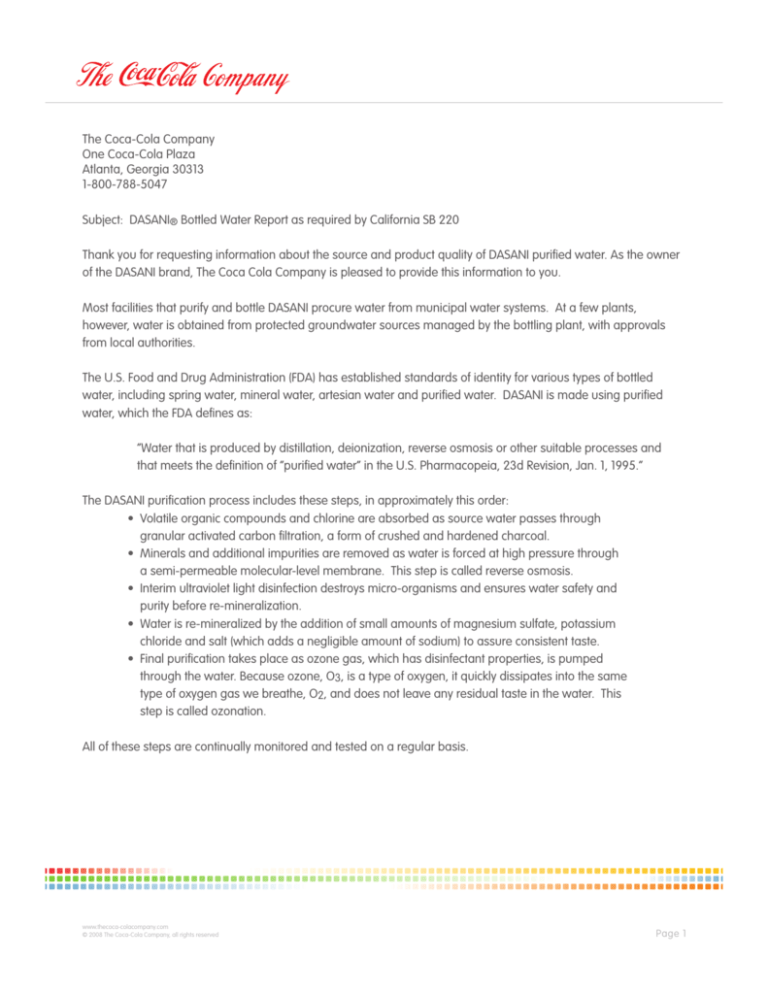
The Coca-Cola Company
One Coca-Cola Plaza
Atlanta, Georgia 30313
1-800-788-5047
Subject: DASANI® Bottled Water Report as required by California SB 220
Thank you for requesting information about the source and product quality of DASANI purified water. As the owner
of the DASANI brand, The Coca Cola Company is pleased to provide this information to you.
Most facilities that purify and bottle DASANI procure water from municipal water systems. At a few plants,
however, water is obtained from protected groundwater sources managed by the bottling plant, with approvals
from local authorities.
The U.S. Food and Drug Administration (FDA) has established standards of identity for various types of bottled
water, including spring water, mineral water, artesian water and purified water. DASANI is made using purified
water, which the FDA defines as:
“Water that is produced by distillation, deionization, reverse osmosis or other suitable processes and
that meets the definition of “purified water” in the U.S. Pharmacopeia, 23d Revision, Jan. 1, 1995.”
The DASANI purification process includes these steps, in approximately this order:
• Volatile organic compounds and chlorine are absorbed as source water passes through
granular activated carbon filtration, a form of crushed and hardened charcoal.
• Minerals and additional impurities are removed as water is forced at high pressure through
a semi-permeable molecular-level membrane. This step is called reverse osmosis.
• Interim ultraviolet light disinfection destroys micro-organisms and ensures water safety and
purity before re-mineralization.
• Water is re-mineralized by the addition of small amounts of magnesium sulfate, potassium
chloride and salt (which adds a negligible amount of sodium) to assure consistent taste.
• Final purification takes place as ozone gas, which has disinfectant properties, is pumped
through the water. Because ozone, O3, is a type of oxygen, it quickly dissipates into the same
type of oxygen gas we breathe, O2, and does not leave any residual taste in the water. This
step is called ozonation.
All of these steps are continually monitored and tested on a regular basis.
www.thecoca-colacompany.com
© 2008 The Coca-Cola Company, all rights reserved
Page 1
“Purified water” has been established as a separate standard of identity because it is distinct in composition from
the source water used to make it. Because of the purification and re-mineralization treatments it receives, DASANI
provides a consistent taste regardless of its source.
Bottled water is a food product under Federal and state law and it must meet standards of quality established by
the FDA. In addition, The Coca-Cola Company’s quality management system has been benchmarked against the
most current internationally recognized third-party requirements. For a report on DASANI’s annual compliance with
FDA bottled water quality standards, visit The Coca Company’s website, www.thecoca-colacompany.com, or the
DASANI brand website, www.dasani.com.
The FDA provides recall information at http://www.fda.gov/opacom/7alerts.html.
The State of California requires that we provide the following definitions and statements as part of this report.
Definitions
“statement of quality” – The standard (statement) of quality for bottled water is the highest level of a contaminant
that is allowed in a container of bottled water, as established by the United States Food and Drug Administration
(FDA) and the California Department of Public Health. The standards can be no less protective of public health than
the standards for public drinking water, established by the U.S. Environmental Protection Agency (EPA) or the
California Department of Public Health.
“maximum contaminant level (MCL)” - The highest level of a contaminant that is allowed in drinking water,
established by the U.S. Environmental Protection Agency (EPA) or the California Department of Public Health.
Primary MCLs are set as close to the PHGs as is economically and technologically feasible.
“public health goal (PHG)” - The level of a contaminant in drinking water below which there is no known or expected
risk to health. PHGs are set by the California Environmental Protection Agency.
“primary drinking water standard” - MCLs for contaminants established by the U.S. Environmental Protection
Agency (EPA) or the California Department of Public Health that affect health along with their monitoring and
reporting requirements, and water treatment requirements.
Statements
“Drinking water, including bottled water, may reasonably be expected to contain at least small amounts of some
contaminants. The presence of contaminants does not necessarily indicate that water poses a health risk. More
information about contaminants and potential health effects can be obtained by calling the United States Food and
Drug Administration, Food and Cosmetic Hotline (1-888-723-3366).”
www.thecoca-colacompany.com
© 2008 The Coca-Cola Company, all rights reserved
Page 2
“Some persons may be more vulnerable to contaminants in drinking water than the general population.
Immuno-compromised persons, including, but not limited to, persons with cancer who are undergoing chemotherapy,
persons who have undergone organ transplants, persons with HIV/AIDS or other immune system disorders, some
elderly persons, and infants can be particularly at risk from infections. These persons should seek advice about
drinking water from their health care providers. The United States Environmental Protection Agency and the Centers
for Disease Control and Prevention guidelines on appropriate means to lessen the risk of
infection by cryptosporidium and other microbial contaminants are available from the Safe Drinking Water Hotline
(1-800-426-4791).”
“The sources of bottled water include rivers, lakes, streams, ponds, reservoirs, springs, and wells. As water naturally travels over the surface of the land or through the ground, it can pick up naturally occurring substances as well
as substances that are present due to animal and human activity.”
“Substances that may be present in the source water include any of the following:
1. Inorganic substances, including, but not limited to, salts and metals, that can be naturally occurring or result from farming, urban stormwater runoff, industrial or domestic wastewater discharges, or oil and
gas production.
2. Pesticides and herbicides that may come from a variety of sources, including, but not limited to,
agriculture, urban stormwater runoff, and residential uses.
3. Organic substances that are byproducts of industrial processes and petroleum production and can also come from gas stations, urban stormwater runoff, agricultural application, and septic systems.
4. Microbial organisms that may come from wildlife, agricultural livestock operations, sewage treatment plants, and septic systems.
5. Substances with radioactive properties that can be naturally occurring or be the result of oil and gas production and mining activities.”
“In order to ensure that bottled water is safe to drink, the United States Food and Drug Administration and the State
Department of Public Health prescribe regulations that limit the amount of certain contaminants in water provided
by bottled water companies.”
www.thecoca-colacompany.com
© 2008 The Coca-Cola Company, all rights reserved
Page 3

